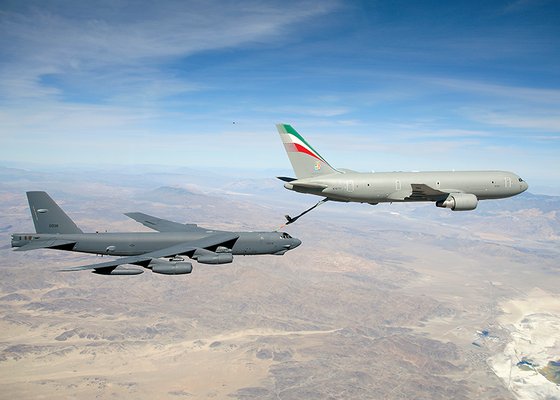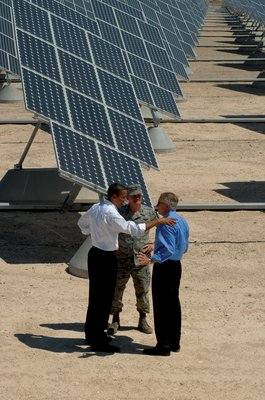
by Michael E. Webber Thursday, January 5, 2012

Refueling Air Force planes in midair increases fuel costs to about $42 per gallon. U.S. Air Force photo by Jet Fabara

The Department of Defense is the world's single largest energy consumer and is poised to help solve the world's energy challenges. Photo: Tech. Sgt. Angela Stafford, USAF

President Barack Obama, Col. Dave Belote and Sen. Harry Reid, D-Nev., tour Nellis Air Force Base. U.S. Air Force photo by Senior Airman Nadine Y. Barclay
Can the Department of Defense solve the world’s energy crisis one jet at a time?
The United States has all the tools it needs to solve the country’s energy problems — and one of the surprising contributors to the solution is none other than the U.S. Department of Defense. Although many look to the Department of Energy to take the lead on energy issues, one of the ironies in the federal government is that, contrary to its name, the Department of Energy historically has been a part of the national security apparatus; it’s a weapons agency that happens to dabble in energy on the side.
The unexpected corollary is that the Department of Defense is much more involved with energy issues than people realize. The department is the world’s largest energy consumer, a guarantor of energy trade, a victim (and beneficiary) of energy-related military tactics and a strategic protector of U.S. interests in energy-rich areas of the world. Because of its great need for energy, the Department of Defense is also increasingly becoming a leader in energy research and development, and in implementing new energy technologies and using alternative fuels. Therefore, the department is a top contender for finding a low-carbon, domestic source of energy that is compatible with existing infrastructure and that satisfies the country’s energy needs just as well as traditional forms of energy.
If the Department of Defense can do that, then it will not only solve the United States’ energy woes, it will also go a long way toward solving the world’s energy challenges.
The Department of Defense is responsible for more than 80 percent of the U.S. government’s energy use and approximately 1 percent of the nation’s annual energy use — more than any other single entity. In 2008, the department consumed approximately 900 trillion British Thermal Units of energy — more than the entire annual consumption of countries such as Bulgaria, Denmark, Israel and New Zealand. The Department of Defense uses its fair share of electricity and requires natural gas, coal and steam for heating, but most of its energy appetite is for liquid fuels: 120 million barrels (5 billion gallons) per year. Jet fuels alone account for more than two-thirds of that liquid energy — fueling the U.S. military’s unparalleled mobility and allowing the country’s armed forces to establish their presence anywhere in the world.
But being a major energy consumer is a double-edged sword: On one hand, it gives the Pentagon a lot of experience with the capabilities and limitations of different energy sources, but it also means the Pentagon is responsible for most of the more than $12 billion the U.S. government spent on energy last year. In addition to the price tag for fuels, the Pentagon spends a significant amount of money moving that fuel around. For example, refueling the Air Force’s planes in midair increases fuel costs to about $42 per gallon. Delivering fuels on the ground to the battle lines costs hundreds of dollars per gallon. The Army alone devotes 60,000 uniformed personnel to transporting fuels worldwide. On top of that, the number of fuels is proliferating along with new technology, doubling from about a half-dozen different battlefield fuels two decades ago to more than a dozen today. This means the military has to pay even more attention to the logistical details of moving fuel.
Because energy use has a critical impact on the Department of Defense’s bottom line, the department has a much greater incentive to find ways to reduce its consumption than the Department of Energy or any other government agency. And because agency budgets are often a zero-sum game, if the Department of Defense can reduce its bill for fuels, then it might have more money available for other purposes. Thus the military, more than any other segment of government, has a direct self-interest in finding an affordable and reliable supply of energy.
One looming energy challenge is that the world’s demand for liquid fuels is projected to grow significantly in the coming decades (from approximately 84 million barrels per day today to more than 110 million barrels per day in 2030), yet the available supplies of conventional energy sources are becoming increasingly constrained. More than two-thirds of the world’s remaining conventional petroleum and natural gas resources are in the countries of the Middle East and the former Soviet Union. Because energy is such a critical economic and political concern for the United States and its allies, keeping the hydrocarbons flowing is a top strategic priority.
As a result, the U.S. military expends a significant portion of its energy stabilizing or protecting energy-rich parts of the world. The military also projects force to keep the world’s avenues of energy commerce open and freely flowing to ensure a stable global economy. Consequently, the U.S. Navy regularly patrols critical energy chokepoints such as the Strait of Hormuz near Iran. And AFRICOM, the U.S. military force created by the Pentagon in 2007 to manage operations in Africa, spends a great deal of time stationed off the coast of West Africa, the continent’s main oil-producing region.
It’s hard to put a price on this total effort, but different analyses estimate that the United States spends somewhere between $29 billion and $143 billion every year just to protect the supply and transit of oil. These expenses mean Americans are paying anywhere from about $9 to $44 of additional hidden military costs for each barrel of petroleum we import from countries other than Canada and Mexico.
All of this energy-inspired intervention worldwide gives many planners in the Pentagon a grave philosophical headache when they realize that we spend significant amounts of energy to stabilize the very regions from which we import those energy resources in the first place. Thus, many in the Pentagon are beginning to ask whether there’s a better way to meet our energy needs that doesn’t require such an exacting toll on money, personnel and energy.
Thankfully, the Department of Defense has some critical policy levers at its disposal to solve its own energy problem. It has firsthand experience producing, distributing and using energy, which comes in handy when developing alternative fuels. In addition, the Department of Defense has a unique ability to enter long-term purchasing agreements for power (20 years or more) and fuels (up to five years), which gives energy developers the revenue stream they need to secure financing to bring large-scale projects online. In today’s tough economic climate, where the inability to obtain financing hobbles many good energy projects, this purchasing power is a valuable asset and can be used to get new biorefineries or novel fuel-production systems over the hump from blueprint to reality.
Perhaps the most important tools at the Department of Defense’s disposal are its significant research budgets, including those for the Defense Advanced Research Projects Agency (DARPA) and the research arms of the different military branches such as the Office of Naval Research and the Air Force Office of Scientific Research. The total amount of R&D money related to energy in the federal government’s entire research portfolio has hovered between $1 billion and $2 billion for the last few years (prior to the big boost from the stimulus package). That’s only a fraction of the $30+ billion we spend on health-related research and miniscule compared to the $80+ billion we spend on defense-related research. Based on sheer size of investments, the Department of Defense has more capacity to conduct effective energy research than all other government agencies combined.
After decades of ceding that bureaucratic turf to the Department of Energy, the Department of Defense is starting to invest its own money to tackle the energy problem.
The Department of Defense clearly has the incentive and wherewithal to
lead the transition to alternative fuels, but there’s another reason why
the department is in a prime position to move society forward on the
energy front: It has stricter performance requirements and thus its
energy challenges are harder to solve.
When it comes to fueling planes and tanks, the U.S. military needs
higher-performing fuels than the Average Joe filling up his truck at the
corner gas station.
The Air Force in particular has special energy needs. Because weight is at a premium when flying, airplane fuels must be very energy-dense. These fuels must also have convenient boiling points to ensure they work in the scorching heat on a tarmac in Iraq and convenient freezing points so they can continue to work in high altitudes. These requirements make ethanol and electricity stored in batteries impractical for aviation applications because they both have much lower energy densities than petroleum-based jet fuels. Consequently, the Department of Defense will have difficulty using conventional, off-the-shelf alternative energy solutions from the ground-based transportation sector to meet its needs.
To complicate matters even more, the Air Force has set an ambitious goal for itself: to fuel half of its North American fleet with domestic fuels made from alternative feedstocks by 2016.
The obvious choice is to use the country’s vast coal resources to make synthetic fuels via the Fischer-Tropsch process, which chemically converts hydrocarbons into custom synthetic blends that can replace gasoline, diesel or jet fuel (also known as coal-to-liquids, or CTL). The Air Force intends to certify its entire fleet on 50/50 blends of petroleum-based jet fuel and CTL synfuels by 2011 and is ahead of schedule: Several planes, including the C-17, B-1 and B-52, are all certified, and the Air Force is already testing the KC-135, F-15, F-22 and the midair refueling fleet. To conduct these tests, the Air Force already consumes more than 300,000 gallons of CTL-based jet fuels annually.
These tests show that CTL fuels work well, but the Air Force experienced a bump along the road to expanding its use of CTLs: the Energy Independence and Security Act of 2007. The act includes a provision targeted at the Air Force, which prohibits it from using CTL fuels for anything other than R&D purposes unless the fuel’s lifecycle greenhouse gas emissions are lower than conventional petroleum. Right now, the lifecycle greenhouse gas emissions of CTL fuels are higher than jet fuels made from conventional petroleum.
But this may be changing. As more jet fuels are produced from unconventional sources (such as the Canadian tar sands), the greenhouse gas emissions of conventional jet fuels may increase. On the other hand, as new technology to capture and sequester carbon from coal mining is developed, the greenhouse gas emissions of CTL fuels may come in line with conventional fuels. So for now, the consequences of the 2007 act remain to be seen.
Although the act may potentially hobble the development of domestic CTL fuels as a replacement for petroleum, it also opens the door for new biofuels. Ethanol does not have a desirable energy density for aviation applications, but jet fuels similar to biodiesel can be made from a few different processes using a range of feedstocks. One of these — algae — is particularly interesting because it is potentially much more productive in terms of gallons of oil that can be produced per acre per year than traditional biofeedstocks such as corn and soy. And because farmers can grow algae with low-quality water (including saltwater in some cases) on nonarable land, algae-based biofuels can avoid competing with agriculture.
Researchers have known for decades that algae are a source of fuel, but developing algae-based fuels has been plagued by prohibitive cost and scale hurdles. That’s where DARPA — the R&D arm of the Pentagon famous for creating the Internet — comes in. DARPA invested upwards of $50 million for a crash-course, 24-month program to generate thousands of gallons of algae-based jet fuels at a price competitive with gasoline. It just might be that DARPA will move algae across the threshold of scalability and affordability.
In the end, the Department of Defense has a large responsibility to help the world avoid energy crises — and does so by stabilizing energy-rich regions and preventing supply cutoffs. But it comes at a huge cost in terms of energy, money and personnel. This complex relationship with energy, combined with the department’s purchasing power, gives it unique motivation, insight and capability to solve the world energy problem. And, in fact, it’s already doing more than most people realize.
The United States has spent decades building the most capable military in the history of the world, and energy just might be one more area where it’s poised to excel.
© 2008-2021. All rights reserved. Any copying, redistribution or retransmission of any of the contents of this service without the expressed written permission of the American Geosciences Institute is expressly prohibited. Click here for all copyright requests.